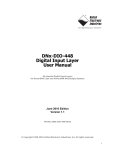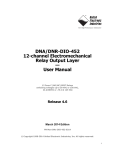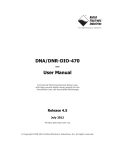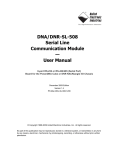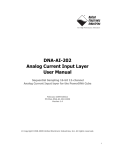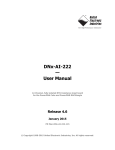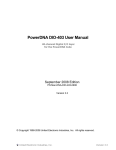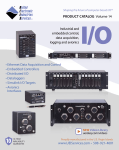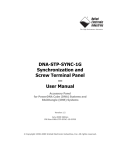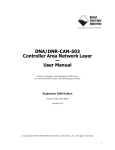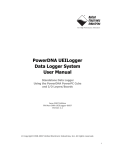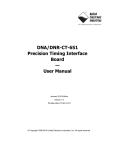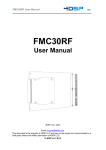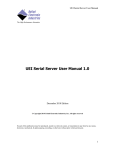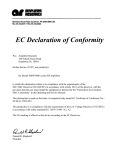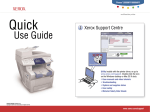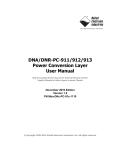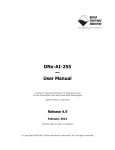Download DNA-DIO-462 Product Manual - United Electronic Industries
Transcript
DNA/DNR-DIO-462 Guardian™ 12-channel Electromechanical Relay Output Layer — User Manual 12 Form C (NO/NC) SPDT Relays Max. Operating Voltage — 220 VDC, 250 VAC Max. Switching Capacity — 94 VA, 90 W Rated Load —2A@30 VDC, 0.75 A@ 150 VAC continuous Release 4.6 March 2014 Edition PN Man-DNx-DIO-462-0314 © Copyright 1998-2013 United Electronic Industries, Inc. All rights reserved. i No part of this publication may be reproduced, stored in a retrieval system, or transmitted, in any form by any means, electronic, mechanical, by photocopying, recording, or otherwise without prior written permission. Information furnished in this manual is believed to be accurate and reliable. However, no responsibility is assumed for its use, or for any infringement of patents or other rights of third parties that may result from its use. All product names listed are trademarks or trade names of their respective companies. See the UEI website for complete terms and conditions of sale: http://www.ueidaq.com/company/terms.aspx Contacting United Electronic Industries Mailing Address: 27 Renmar Avenue Walpole, MA 02081 U.S.A. For a list of our distributors and partners in the US and around the world, please see http://www.ueidaq.com/partners/ Support: Telephone: Fax: (508) 921-4600 (508) 668-2350 Also see the FAQs and online “Live Help” feature on our web site. Internet Support: Support: Web-Site: FTP Site: [email protected] www.ueidaq.com ftp://ftp.ueidaq.com Product Disclaimer: WARNING! DO NOT USE PRODUCTS SOLD BY UNITED ELECTRONIC INDUSTRIES, INC. AS CRITICAL COMPONENTS IN LIFE SUPPORT DEVICES OR SYSTEMS. Products sold by United Electronic Industries, Inc. are not authorized for use as critical components in life support devices or systems. A critical component is any component of a life support device or system whose failure to perform can be reasonably expected to cause the failure of the life support device or system, or to affect its safety or effectiveness. Any attempt to purchase any United Electronic Industries, Inc. product for that purpose is null and void and United Electronic Industries Inc. accepts no liability whatsoever in contract, tort, or otherwise whether or not resulting from our or our employees' negligence or failure to detect an improper purchase. NOTE— Specifications in this document are subject to change without notice. Check with UEI for current status. ii Table of Contents Chapter 1 Introduction .................................................... 1 1.1 Organization of this Manual . . . . . . . . . . . . . . . . . . . . . . . . . . . . . . . . . . . . . . . . . . . . 1 1.2 The DIO-462 Layer . . . . . . . . . . . . . . . . . . . . . . . . . . . . . . . . . . . . . . . . . . . . . . . . . . . 3 1.3 Features . . . . . . . . . . . . . . . . . . . . . . . . . . . . . . . . . . . . . . . . . . . . . . . . . . . . . . . . . . . 5 1.4 1.4.1 1.4.2 Device Architecture. . . . . . . . . . . . . . . . . . . . . . . . . . . . . . . . . . . . . . . . . . . . . . . . . . . 6 Guardian Feature. . . . . . . . . . . . . . . . . . . . . . . . . . . . . . . . . . . . . . . . . . . . . . . 6 Circuit Breaker Function . . . . . . . . . . . . . . . . . . . . . . . . . . . . . . . . . . . . . . . . . 6 1.5 1.5.1 Layer Connectors and Wiring . . . . . . . . . . . . . . . . . . . . . . . . . . . . . . . . . . . . . . . . . . . 7 Jumper Settings . . . . . . . . . . . . . . . . . . . . . . . . . . . . . . . . . . . . . . . . . . . . . . . . 8 1.6 Anti-Kickback Diodes . . . . . . . . . . . . . . . . . . . . . . . . . . . . . . . . . . . . . . . . . . . . . . . . . 9 Chapter 2 Programming with the High Level API . . . . . . . . . . . . . . . . . . . . . . . . . . . . . . 10 2.1 2.1.1 2.1.2 2.1.3 Creating a Session . . . . . . . . . . . . . . . . . . . . . . . . . . . . . . . . . . . . . . . . . . . . . . . . . . Configuring the Resource String . . . . . . . . . . . . . . . . . . . . . . . . . . . . . . . . . . Configuring the Timing . . . . . . . . . . . . . . . . . . . . . . . . . . . . . . . . . . . . . . . . . . Writing Data to the Output Port . . . . . . . . . . . . . . . . . . . . . . . . . . . . . . . . . . . 10 10 11 11 2.2 Monitoring the Current . . . . . . . . . . . . . . . . . . . . . . . . . . . . . . . . . . . . . . . . . . . . . . . 11 2.3 Cleaning-up the Session. . . . . . . . . . . . . . . . . . . . . . . . . . . . . . . . . . . . . . . . . . . . . . 12 Chapter 3 Programming with the Low-level API . . . . . . . . . . . . . . . . . . . . . . . . . . . . . . . 13 Appendix A - Accessories. . . . . . . . . . . . . . . . . . . . . . . . . . . . . . . . . . . . . . . . . . . . . . . . . . . 14 Index . . . . . . . . . . . . . . . . . . . . . . . . . . . . . . . . . . . . . . . . . . . . . . . . . . . . . . . . . . . . . . . . . . 15 © Copyright 2010 United Electronic Industries, Inc. Tel::508-921-4600 Date: March 2014 www.ueidaq.com Vers: 1.0 DNA-DIO-462-ManualTOC.fm List of Figures Chapter 1 Introduction . . . . . . . . . . . . . . . . . . . . . . . . . . . . . . . . . . . . . . . . . . . . . . . . . . . . 1 1-1 A DNR-DIO-462 Digital I/O Layer .................................................................................. 4 1-2 DNx-DIO-462 Device Architecture ................................................................................. 6 1-3 DB-37 I/O Connector Pinout .......................................................................................... 7 1-4 Physical Layout of DNA-DIO-462 Layer Board.............................................................. 8 1-5 Diagram of DNA-DIO-462 Layer Position Jumper Settings ........................................... 8 © Copyright 2010 United Electronic Industries, Inc. Tel::508-921-4600 Date: March 2014 www.ueidaq.com Vers: 1.3 DNA-DIO-462-ManualLOF.fm DNx-DIO-462 Relay Output Board Chapter 1 Introduction Chapter 1 Introduction This document outlines the feature set and use of the DNA/DNR-DIO-462 electromechanical relay output layer when used with the PowerDNA I/O Cube or RACKtangle chassis, respectively. 1.1 Organization This PowerDNA DNx-DIO-462 User Manual is organized as follows: of this Manual • Introduction This chapter provides an overview of PowerDNA DNx-DIO-462 Electromechanical Relay Drive Output board features, accessories, and software. © Copyright 2010 all rights reserved United Electronic Industries, United Electronic Industries, Inc. Tel: 781-821-2890 Inc. • The DIO-462 Layer This chapter provides an overview of the device architecture, connectivity, and logic of the DNx-DIO-462 layer. • Programming with the High-Level API This chapter provides a general description of the how to create a session, configure the session for relay drive/output, and format relevant data. • Programming with the Low-Level API This chapter describes Low-level API commands for configuring and using the DNx-DIO-462 layer. • Appendix – Accessories This appendix describes the accessories available for use with the DNx-DIO-462 layer. • Index This is an alphabetical listing of the topics covered in this manual. Tel: 508-921-4600 www.ueidaq.com Date: March Printed 2014 03. 05. 2014 www.ueidaq.com Vers:0.5 4.6 File: DNA-DIO-462 Fax: 781-821-2891 Chap1.fm 1 DNx-DIO-462 Relay Output Board Chapter 1 Introduction Manual Conventions To help you get the most out of this manual and our products, please note that we use the following conventions: Tips are designed to highlight quick ways to get the job done, or reveal good ideas you might not discover on your own. NOTE: Notes alert you to important information. CAUTION! advises you of precautions to take to avoid injury, data loss, and damage to your boards or a system crash. Text formatted in bold typeface generally represents text you should be entered verbatim. For instance, it can represent a command, as in the following example: “You can instruct users how to run setup using a command such as setup.exe.” Before plugging any I/O connector into the Cube or Layer, be sure to remove power from all field wiring. Failure to do so may cause severe damage to the equipment. © Copyright 2010 all rights reserved United Electronic Industries, United Electronic Industries, Inc. Tel: 781-821-2890 Inc. Tel: 508-921-4600 www.ueidaq.com Date: March Printed 2014 03. 05. 2014 www.ueidaq.com Vers:0.5 4.6 File: DNA-DIO-462 Fax: 781-821-2891 Chap1.fm 2 DNx-DIO-462 Relay Output Board Chapter 1 Introduction 1.2 The DIO-462 Layer The DNx-DIO-462 is a 12-channel Electromechanical Relay Output Layer designed for driving solenoids, motors, or other inductive loads attached to a PowerDNA Cube or RACKtangle. The board is available in two versions, the DNA-DIO-462 for mounting in UEI Cube products, and DNR-DIO-462, for insertion into UEI RACKtangle and HalfRACK chassis. The DNx-DIO-462 has 12 digital outputs that can be configured to provide output control for 12 channels (total). The maximum current drive is 2 A @ 30 VDC per channel (or 0.75A @ 125 VAC). NOTE: Users who connect inductive loads to the DIO-462 must provide antikickback diodes on each such output. The technical specifications for the DIO-462 layer are listed in Table 1-1 below. Table 1-1. DNx-DIO-462 Technical Specifications Technical Specifications: Output specifications Rated Load Max Switching Capacity Max Operating Voltage Min Permissible Load Contact Material Contact ON impedance Contact OFF impedance Off Leakage Current Turn-On Time Turn-Foff Time Max Operating Freq. Service Life Mechanical Electrical Monitor/circuit breaker specs Resolution Range © Copyright 2010 all rights reserved United Electronic Industries, United Electronic Industries, Inc. Tel: 781-821-2890 Inc. 2 A at 30 VDC, 0.75 A at 125 VAC continuous 94 VA, 90 W 220 VDC, 250 VAC 10 μA, 10 mVDC Ag (Au clad) 200 mOhm max (at the I/O connector) >100 MOhm < 100 μA 4 mS max, 2.5 mS typ 4 mS max, 1.5 mS typ 125 operations/second (36000/hour limit) 100 000 000 min 100 000 at 2 A 30 VDC or 0.75 A and 125 VAC 16 bit +150/-30 VDC ±2 A DC 0.3-2 A AC -55/+100 °C Accuracy DC Voltage DC Current AC Voltage Relay Temperature Protection DC Voltage DC Current AC Current Relay Temperature Disconnection Time Power up / reboot state Power dissipation Isolation Operating Temp. Range Operating Humidity Vibration IEC 60068-2-6 IEC 60068-2-64 Shock IEC 60068-2-27 5% of measurement + 0.25% of the full scale 5% of measurement + 0.25% of the full scale 15% of measurement + 1% of the full scale ±2 °C typ (only one type activated per channel) ±5 V to ±220 V 50 mA to 2 A 400 mA to 2 A 0-85 °C 1 sec Off (NC Energized) < 3.5 W 350 Vrms Tested -40 to +85 °C 95%, non-condensing 5 g, 10-500 Hz, sinusoidal 5 g (rms), 10-500 Hz, broad-band random MTBF 260,000 hours 50 g, 3 ms half sine, 18 shocks @ 6 orientations 30 g, 11 ms half sine, 18 shocks @ 6 orientations Tel: 508-921-4600 www.ueidaq.com Date: March Printed 2014 03. 05. 2014 www.ueidaq.com Vers:0.5 4.6 File: DNA-DIO-462 Fax: 781-821-2891 Chap1.fm 3 DNx-DIO-462 Relay Output Board Chapter 1 Introduction Figure 1-1 is a photo of the DNR-DIO-462 version of the DNx-DIO-462 board. The DNA version is functionally identical except that it is designed for insertion into a UEI Cube-type chassis 120-pin DNR bus connector IRQ Jumpers (Do not change) DB-37 (female) 37-pin I/O connector Figure 1-1. A DNR-DIO-462 Digital I/O Layer © Copyright 2010 all rights reserved United Electronic Industries, United Electronic Industries, Inc. Tel: 781-821-2890 Inc. Tel: 508-921-4600 www.ueidaq.com Date: March Printed 2014 03. 05. 2014 www.ueidaq.com Vers:0.5 4.6 File: DNA-DIO-462 Fax: 781-821-2891 Chap1.fm 4 DNx-DIO-462 Relay Output Board Chapter 1 Introduction 1.3 Features The main features of the PowerDNx DNA-DIO-462 Relay Drive Output Layer are: • • • • • • • • • • • • • • © Copyright 2010 all rights reserved United Electronic Industries, United Electronic Industries, Inc. Tel: 781-821-2890 Inc. 12 Form C electromechanical relay outputs (total) 2A @ 30VDC or 0.75A @125 VAC continuous per channel maximum current rating 220 VDC or 250 VAC maximum operating voltage Ideal for driving solenoids, motors, or other inductive loads (user must provide anti-kickback diodes) 10 uA, 10 mV DC min permissible Load Programmable Overcurrent Duration Limits Monitors each channel’s output voltage and current, allowing automatic detection of shorts/opens and other system failures DNR-DIO-462 for use with RACKtangle I/O chassis DNA-DIO-462 for use with “Cube” I/O chassis 200 milliOhm ON resistance (not including cable) Output Throughput rate 125 updates per second max Interrupt on over- and under-current conditions Contact Material Ag (Au clad) OFF leakage current <100 uA Tel: 508-921-4600 www.ueidaq.com Date: March Printed 2014 03. 05. 2014 www.ueidaq.com Vers:0.5 4.6 File: DNA-DIO-462 Fax: 781-821-2891 Chap1.fm 5 DNx-DIO-462 Relay Output Board Chapter 1 Introduction 1.4 Device Architecture The DNx-DIO-462 Layer has 12 Form C relay outputs. A block diagram of the board is shown in Figure 1-2. Block Diagram: Converter Digital Isolator Relays 32-bit 66-MHz bus A/D Divider Relay Drivers Voltage Control Logic DC/DC Sense Resistors I/O Connector Each relay provides the functionality shown Optical Isolation Figure 1-2. DNx-DIO-462 Device Architecture Note that the I/O part of the layer is isolated from the logic interface and that overload protection is provided on all output lines. 1.4.1 Guardian Feature As shown in Figure 1-2, the Guardian feature of the DIO-462 monitors the voltage drop across a series resistor in the circuit of each output relay, continuously sensing AC current, DC current, and output voltage relative to the COM terminal. An on-board ADC detects undercurrent, overcurrent, shorts, opens, and other off-normal conditions (such as high/low temperature), all of which are userprogrammable as to magnitude and/or duration. The Guardian feature is a valuable diagnostic and troubleshoooting tool for ensuring system uptime. 1.4.2 Circuit Breaker Function The DIO-462 can be programmed to provide a circuit breaker function when any of the measurements exceeds a user-defined limit. After a fault is detected, this circuit breaker function can be set to re-connect in either of 2 ways: • Auto reconnect: In this mode, the board will reconnect after a 1 second delay and test the limit again. This will result in the relay continually cycling on and off until the overlimit condition is resolved. • User re-enable: In this mode, the relay will be set to the OFF state and remain there until the user software re-writes the ON command to the relay. A ‘1’ written to the digital output for any given relay will switch the relay ON, which connects COM to the N.O. contact.The circuit breaker function always acts to return the relay to the ‘0’ or OFF state, which will connect the COM back to the N.C. contact. Thus, the circuit breaker can only disconnect a current that is flowing through the COM-N.O. connection. The user program can always read the current flowing through the relay regardless of which state the contacts are in. When measuring voltage, the situation is reversed from the current measurement. In such cases, the voltage will be zero for the contact that is connected to the COM terminal and will be readable for the disconnected terminal. © Copyright 2010 all rights reserved United Electronic Industries, United Electronic Industries, Inc. Tel: 781-821-2890 Inc. Tel: 508-921-4600 www.ueidaq.com Date: March Printed 2014 03. 05. 2014 www.ueidaq.com Vers:0.5 4.6 File: DNA-DIO-462 Fax: 781-821-2891 Chap1.fm 6 DNx-DIO-462 Relay Output Board Chapter 1 Introduction The limit set function used by the breaker circuit always assumes that a voltage or current farther from zero is greater than one that is closer to zero. For example, a current limit of +200mA will disconnect when a current of +201mA is detected and a current limit of negative 200mA will disconnect with a current of -201mA. 1.5 Layer Connectors and Wiring The pinout of the DB-37 37-pin female connector for the DNx-DIO-462 Layer board is shown in Figure 1-3. NC-0 - 1 COM-0 - 2 NO-1 - 3 NC-2 - 4 COM-2 - 5 NO-3 - 6 NC-4 - 7 COM-4 - 8 NO-5 - 9 NC-6 - 10 COM-6 - 11 NO-7 - 12 NC-8 - 13 COM-8 - 14 NO-9 - 15 NC-10 - 16 COM-10 - 17 NO-11 - 18 rsvd - 19 20 21 22 23 24 25 26 27 28 29 30 31 32 33 34 35 36 37 - NO-0 - NC-1 - COM-1 - NO-2 - NC-3 - COM-3 - NO-4 - NC-5 - COM-5 - NO-6 - NC-7 - COM-7 - NO-8 - NC-9 - COM-9 - NO-10 - NC-11 - COM-11 Figure 1-3. DB-37 I/O Connector Pinout For software compatibility with other UEI DIO products, the 12 output groups of the DIO-462 are numbered from NO-0, NC-0, COM-0 through NO-11, NC-11, COM-11. Note that the output of each channel is a set of three pins for NC contacts, NO contacts, and COM. DO 0 uses AI channels 0 to 4 to measure NO voltage, DC current, AC current, NC voltage and ADC temperature; and in a similar way for remaining channels: DO 0 DO 1 DO 2 DO 3 DO 4 DO 5 DO 6 DO 7 DO 8 DO 9 DO 10 DO 11 © Copyright 2010 all rights reserved United Electronic Industries, United Electronic Industries, Inc. Tel: 781-821-2890 Inc. NO DC AC NC °t 0 1 2 3 4 8 9 10 11 12 16 17 18 19 20 24 25 26 27 28 32 33 34 35 36 40 41 42 43 44 48 49 50 51 52 56 57 58 59 60 64 65 66 67 68 72 73 74 75 76 80 81 82 83 84 88 89 90 91 92 Tel: 508-921-4600 www.ueidaq.com Date: March Printed 2014 03. 05. 2014 www.ueidaq.com Vers:0.5 4.6 File: DNA-DIO-462 Fax: 781-821-2891 Chap1.fm 7 DNx-DIO-462 Relay Output Board Chapter 1 Introduction When power is provided to the layer, the RDY LED on the PowerDNA Cube turns on. When no power is supplied, the RDY LED is off, and the DNx-DIO-462 layer cannot operate. Before plugging any I/O connector into the Cube or Layer, be sure to remove power from all field wiring. Failure to do so may cause severe damage to the equipment. 1.6 Anti-Kickback Diodes CAUTION! Use of the DIO-462 to drive inductive loads requires installation of anti-kickback diodes on each such output. Installation of these diodes is the responsibility of the user. Failure to provide these diodes can cause damage to components of the board. © Copyright 2010 all rights reserved United Electronic Industries, United Electronic Industries, Inc. Tel: 781-821-2890 Inc. Tel: 508-921-4600 www.ueidaq.com Date: March Printed 2014 03. 05. 2014 www.ueidaq.com Vers:0.5 4.6 File: DNA-DIO-462 Fax: 781-821-2891 Chap1.fm 8 DNx-DIO-462 Relay Output Board Chapter 2 Programming with the High Level API Chapter 2 Programming with the High Level API This section describes how to control the DNA-DIO-462 using the UeiDaq Framework High Level API. UeiDaq Framework is object oriented and its objects can be manipulated in the same manner from different development environments such as Visual C++, Visual Basic or LabVIEW. The following section focuses on the C++ API, but the concept is the same no matter what programming language you use. Please refer to the “UeiDaq Framework User Manual” for more information on use of other programming languages. 2.1 Creating a Session The Session object controls all operations on your PowerDNA device. Therefore, the first task is to create a session object: CUeiSession session; 2.1.1 Configuring the Resource String UeiDaq Framework uses resource strings to select which device, subsystem and channels to use within a session. The resource string syntax is similar to a web URL: <device class>://<IP address>/<Device Id>/<Subsystem><Channel list> For PowerDNA, the device class is pdna. For example, the following resource string selects digital output channels 0,1,2,3 on device 1 at IP address 192.168.100.2: "pdna://192.168.100.2/Dev1/Do0:3" NOTE: In Framework, a digital channel corresponds to a physical port on the device. You cannot configure a session only to access a subset of lines within a digital port. NOTE: Sessions are unidirectional. If your device has both input and output ports or has bidirectional ports, you need to configure two sessions: one for input and one for output. The DIO-462 is known as an intelligent digital output device. It can monitor the current flowing through each of its digital lines and open or close a line when the current goes above or below specified current limits. You can configure the device to attempt to close the connection after a programmed delay whenever an over- or under-current condition occurs. The following call configures the digital output port of a DIO-462 set as device 1: // Configure session to write to port 0 on device 1 session.CreateDOProtectedChannel("pdna://192.168.100.2/Dev1/Do0", -0.01, 0.01, 200.0, false, 50.0); © Copyright 2010 all rights reserved United Electronic Industries, United Electronic Industries, Inc. Tel: 781-821-2890 Inc. Tel: 508-921-4600 www.ueidaq.com Date: March Printed 2014 03. 05. 2014 www.ueidaq.com Vers:0.5 4.6 File: DNA-DIO-462 Fax: 781-821-2891 Chap2.fm 10 DNx-DIO-462 Relay Output Board Chapter 2 Programming with the High Level API It configures the following parameters: 2.1.2 Configuring the Timing • Under-current limit: when the current goes below this limit, the line opens. • Over-current limit: when the current goes above this limit, the line opens. • Current sampling rate: the rate at which the DIO-462 monitors current. This rate has a direct influence on how fast the DIO-462 reacts to an under or over-current condition. • The retry status: specifies whether the DIO-462 attempts to close the circuit after an over or under current condition. • The retry rate: specifies how often the DIO-462 attempts to close the circuit. You can configure the DNA-DIO-462 to run in simple mode (point by point) only. Use of ACB mode is not currently supported. In simple mode, the delay between samples is determined by software on the host computer. The following sample shows how to configure the simple mode. Please refer to the “UeiDaq Framework User’s Manual” to learn how to use the other timing modes. session.ConfigureTimingForSimpleIO(); 2.1.3 Writing Data to Writing data is done using a writer object. The following sample shows how to create a writer object and write data. the Output Port // Create a writer and link it to the session’s stream CUeiDigitalWriter writer(session.GetDataStream()); // write one scan, the buffer must contain // one value per channel uInt32 data = 0xFEFE; writer.WriteSingleScan(&data); 2.2 Monitoring the Current You can monitor the current measured at each digital line. Use an analog Input session the same way you would measure voltage from an analog Input device. The following code shows how to measure current out of the first 4 digital lines: CUeiSession aiSs; aiSs.CreateAIChannel("pdna://192.168.100.2/Dev1/Ai0:3" -10.0, 10.0, UeiAIChannelInputModeDifferential); aiSs.ConfigureTimingForSimpleIO(); CUeiAnalogScaledReader aiReader(aiSs.GetDataStream()); double currents[8]; aiReader.ReadSingleScan(currents); © Copyright 2010 all rights reserved United Electronic Industries, United Electronic Industries, Inc. Tel: 781-821-2890 Inc. Tel: 508-921-4600 www.ueidaq.com Date: March Printed 2014 03. 05. 2014 www.ueidaq.com Vers:0.5 4.6 File: DNA-DIO-462 Fax: 781-821-2891 Chap2.fm 11 DNx-DIO-462 Relay Output Board Chapter 2 Programming with the High Level API 2.3 Cleaning-up the Session The session object will clean itself up when it goes out of scope or when it is destroyed. To reuse the object with a different set of channels or parameters, you can manually clean up the session as follows: session.CleanUp(); © Copyright 2010 all rights reserved United Electronic Industries, United Electronic Industries, Inc. Tel: 781-821-2890 Inc. Tel: 508-921-4600 www.ueidaq.com Date: March Printed 2014 03. 05. 2014 www.ueidaq.com Vers:0.5 4.6 File: DNA-DIO-462 Fax: 781-821-2891 Chap2.fm 12 DNx-DIO-462 Relay Output Board Chapter 3 Programming with the Low-level API Chapter 3 Programming with the Low-level API The low-level API offers direct access to PowerDNA DAQBios protocol and allows you to directly access device registers. Where possible, we recommend that you use the UeiDaq Framework (see Chapter 2), which is easier to use. You should need to use the low-level API only if you are using an operating system other than Windows. Please refer to the API Reference Manual document under: Start » Programs » UEI » PowerDNA » Documentation for pre-defined types, error codes, and functions for use with this layer. © Copyright 2010 all rights reserved United Electronic Industries, United Electronic Industries, Inc. Tel: 781-821-2890 Inc. Tel: 508-921-4600 www.ueidaq.com Date: March Printed 2014 03. 05. 2014 www.ueidaq.com Vers:0.5 4.6 File: DNA-DIO-462 Fax: 781-821-2891 Chap3.fm 13 DNx-DIO-462 Layer Appendix A. Accessories The following cables and STP boards are available for the DIO-462 layer. DNA-CBL-37 A 3ft, 37-way flat ribbon cable that connects the layer to a terminal panel. DNA-STP-37 37-way screw terminal panel. © Copyright 2010 all rights reserved United Electronic Industries, United Electronic Industries, Inc. Tel: 781-821-2890 Inc. Tel: 508-921-4600 www.ueidaq.com Date: March Printed 2014 03. 05. 2014 www.ueidaq.com Vers:0.5 4.6 File: DNA-DIO-462 Fax: 781-821-2891 Appx.fm 14 15 Index A Low-level API Architecture 6 B M Monitoring the Current Block Diagram 6 O C Organization Cable(s) 14 Caution 7 Cleaning-up the Session 12 Configuring the Resource String Configuring the Timing 11 Conventions 2 Creating a Session 10 D Description F Features 13 10 5 High Level API Jumper Settings Photo of DIO-462 4 Physical Layout 8 Pinout 7 S Screw Terminal Panels 14 Specifications 3 Support ii Support email [email protected] ii Support FTP Site ftp //ftp.ueidaq.com ii 10 J 1 P 3 H 11 Support Web Site www.ueidaq.com 8 ii W Writing Data to the Output Port 11 L Layer Position Jumper Settings 8 © Copyright 2010 United Electronic Industries, Inc. Tel: 508-921-4600 Date: March 2014 www.ueidaq.com Vers: 4.6 File: DNA-DIO-462-ManualIX.fm


















